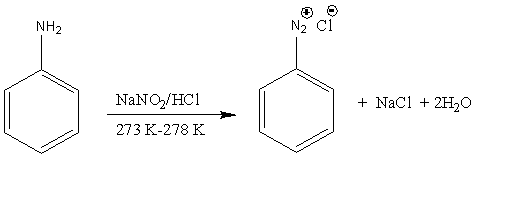
\[{\rm{C}}{{\rm{H}}_{\rm{3}}}{\rm{CON}}{{\rm{H}}_{\rm{2}}} \overset{NaNO_{2/HCl}}{\rightarrow} {\rm{X}}\] ; X is ____
A.\[{\rm{C}}{{\rm{H}}_{\rm{3}}}{\rm{COOH}}\]
B.\[{\rm{C}}{{\rm{H}}_{\rm{3}}}{\rm{CON}}{{\rm{H}}_{\rm{3}}}{\rm{C}}{{\rm{l}}^ - }\]
C.\[{\rm{C}}{{\rm{H}}_{\rm{3}}}{\rm{N}}{{\rm{H}}_{\rm{2}}}\]
D.\[{\rm{C}}{{\rm{H}}_{\rm{3}}}{\rm{CHO}}\]
Answer
221.7k+ views
Hint The general name of the compound ethanamide is acetamide. It is chemically represented as \[{\rm{C}}{{\rm{H}}_{\rm{3}}}{\rm{CON}}{{\rm{H}}_{\rm{2}}}\] . It is prepared from ethanoic acid. In laboratory preparation, it is prepared from ammonium acetate via the process of dehydration. Here, we have to find the product of the reaction acetamide with sodium nitrate in an acidic medium.
Complete step by step answer:
Let’s understand the reaction of acetamide with sodium nitrate in the acidic medium of HCl. Amide undergoes a reaction with nitrous acid (\[{\rm{HN}}{{\rm{O}}_{\rm{2}}}\]) to give product of carboxylic acid.
But, the nature of nitrous is very unstable. Therefore, its preparation is done in situ by the reaction of sodium nitrite with dilute sulphuric acid (\[{{\rm{H}}_{\rm{2}}}{\rm{S}}{{\rm{O}}_{\rm{4}}}\]) or hydrochloric acid (HCl) without the presence of heat. The chemical reaction is,
\[{\rm{NaN}}{{\rm{O}}_{\rm{2}}}\left( s \right) + {\rm{HCl}}\left( {aq} \right) \to {\rm{NaCl}}\left( {aq} \right) + \mathop {{\rm{HN}}{{\rm{O}}_{\rm{2}}}}\limits_{{\rm{Nitric}}\,{\rm{acid}}} \]
Now, the nitric acid undergoes a reaction with amide to give acetic acid. The reaction is,
\[{\rm{C}}{{\rm{H}}_{\rm{3}}}{\rm{CON}}{{\rm{H}}_{\rm{2}}} + {\rm{HN}}{{\rm{O}}_{\rm{2}}} \to {\rm{C}}{{\rm{H}}_{\rm{3}}}{\rm{COOH}} + {{\rm{N}}_{\rm{2}}} + {{\rm{H}}_{\rm{2}}}{\rm{O}}\]
Therefore, X is \[{\rm{C}}{{\rm{H}}_{\rm{3}}}{\rm{COOH}}\]. Hence, option A is right.
Additional Information:
When aniline undergoes a reaction with nitrous acid at the temperature of 273K -278K, it results in the formation of benzenediazonium chloride. The production of nitrous acid is due to the reaction of sodium nitrile with hydrochloric acid.
Let’s understand the diazotization reaction in detail. In the diazotization reaction, the primary aromatic amine converts into diazonium salt.

Image: Diazotization reaction
Note: The nature of nitrous acid is monoprotic and weak. Its use in the preparation of diazonium salts from amines is the most important one. In azo coupling reaction, diazonium salts acts as reagents to give azo dyes as a product. Its use as an oxidizer in liquid fuel rockets is also significant.
Complete step by step answer:
Let’s understand the reaction of acetamide with sodium nitrate in the acidic medium of HCl. Amide undergoes a reaction with nitrous acid (\[{\rm{HN}}{{\rm{O}}_{\rm{2}}}\]) to give product of carboxylic acid.
But, the nature of nitrous is very unstable. Therefore, its preparation is done in situ by the reaction of sodium nitrite with dilute sulphuric acid (\[{{\rm{H}}_{\rm{2}}}{\rm{S}}{{\rm{O}}_{\rm{4}}}\]) or hydrochloric acid (HCl) without the presence of heat. The chemical reaction is,
\[{\rm{NaN}}{{\rm{O}}_{\rm{2}}}\left( s \right) + {\rm{HCl}}\left( {aq} \right) \to {\rm{NaCl}}\left( {aq} \right) + \mathop {{\rm{HN}}{{\rm{O}}_{\rm{2}}}}\limits_{{\rm{Nitric}}\,{\rm{acid}}} \]
Now, the nitric acid undergoes a reaction with amide to give acetic acid. The reaction is,
\[{\rm{C}}{{\rm{H}}_{\rm{3}}}{\rm{CON}}{{\rm{H}}_{\rm{2}}} + {\rm{HN}}{{\rm{O}}_{\rm{2}}} \to {\rm{C}}{{\rm{H}}_{\rm{3}}}{\rm{COOH}} + {{\rm{N}}_{\rm{2}}} + {{\rm{H}}_{\rm{2}}}{\rm{O}}\]
Therefore, X is \[{\rm{C}}{{\rm{H}}_{\rm{3}}}{\rm{COOH}}\]. Hence, option A is right.
Additional Information:
When aniline undergoes a reaction with nitrous acid at the temperature of 273K -278K, it results in the formation of benzenediazonium chloride. The production of nitrous acid is due to the reaction of sodium nitrile with hydrochloric acid.
Let’s understand the diazotization reaction in detail. In the diazotization reaction, the primary aromatic amine converts into diazonium salt.

Image: Diazotization reaction
Note: The nature of nitrous acid is monoprotic and weak. Its use in the preparation of diazonium salts from amines is the most important one. In azo coupling reaction, diazonium salts acts as reagents to give azo dyes as a product. Its use as an oxidizer in liquid fuel rockets is also significant.
Recently Updated Pages
Is PPh3 a strong ligand class 12 chemistry JEE_Main

JEE Main 2025-26 Mock Test: Organic Compounds Containing Nitrogen

JEE Main 2025-26 Organic Compounds Containing Nitrogen Mock Test

Full name of DDT is A 111trichloro22bispchlorophenyl class 12 chemistry JEE_Main

JEE Main Mock Test 2025-26: Purification & Characterisation of Organic Compounds

JEE Main Chemical Kinetics Mock Test 2025-26: Free Practice Online

Trending doubts
JEE Main 2026: Application Form Open, Exam Dates, Syllabus, Eligibility & Question Papers

Derivation of Equation of Trajectory Explained for Students

Hybridisation in Chemistry – Concept, Types & Applications

Understanding the Angle of Deviation in a Prism

How to Convert a Galvanometer into an Ammeter or Voltmeter

Degree of Dissociation: Meaning, Formula, Calculation & Uses

Other Pages
Solutions Class 12 Chemistry Chapter 1 CBSE Notes - 2025-26

NCERT Solutions For Class 12 Chemistry Chapter 1 Solutions - 2025-26

The D and F Block Elements Class 12 Chemistry Chapter 4 CBSE Notes - 2025-26

NCERT Solutions for Class 12 Chemistry Chapter Chapter 7 Alcohol Phenol and Ether

NCERT Solutions ForClass 12 Chemistry Chapter Chapter 8 Aldehydes Ketones And Carboxylic Acids

JEE Advanced Marks vs Ranks 2025: Understanding Category-wise Qualifying Marks and Previous Year Cut-offs




